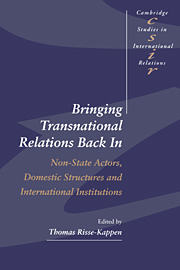 Bringing Transnational Relations Back In
Bringing Transnational Relations Back In Published online by Cambridge University Press: 02 December 2009
Introduction
At the Paris meeting of the Conference on Security and Cooperation in Europe (CSCE), called in November 1990 to mark a new departure in post-Cold War international relations, the leaders of the then thirty-four states of the old East and West blocs paid tribute to the people on the streets who, in the last few weeks of 1989, had changed the course of history.
On the face of it, the role of “people power” was obvious. In country after country, popular pressure had forced totalitarian regimes to collapse or make transitions to democracy. In Poland, Hungary, East Germany, Czechoslovakia, Bulgaria, and Romania, supposedly strong governments disintegrated before spontaneous, unarmed demonstrations. The rapid de-legitimation of the single-party state went against all predictions. But it happened, in a highly visible and unambiguous way, in front of the world's television cameras.
It is not so obvious, though, how these popular forces had managed to prevail, and whether their role was determining, or peripheral in comparison to other processes of transformation which were happening independently. It is equally not obvious whether the situations in the six countries were comparable, nor whether the differences in outcome were determined entirely by domestic politics, or by variables which transcended national boundaries.
In order to probe the impact of what are generally known as the new social movements on the events of 1989,1 have set out in this chapter to reassess the revolutions in Eastern Europe in the light of two independent variables, one domestic and one transnational, related to the existence of these social movements.
To save this book to your Kindle, first ensure [email protected] is added to your Approved Personal Document E-mail List under your Personal Document Settings on the Manage Your Content and Devices page of your Amazon account. Then enter the ‘name’ part of your Kindle email address below. Find out more about saving to your Kindle.
Note you can select to save to either the @free.kindle.com or @kindle.com variations. ‘@free.kindle.com’ emails are free but can only be saved to your device when it is connected to wi-fi. ‘@kindle.com’ emails can be delivered even when you are not connected to wi-fi, but note that service fees apply.
Find out more about the Kindle Personal Document Service.
To save content items to your account, please confirm that you agree to abide by our usage policies. If this is the first time you use this feature, you will be asked to authorise Cambridge Core to connect with your account. Find out more about saving content to Dropbox.
To save content items to your account, please confirm that you agree to abide by our usage policies. If this is the first time you use this feature, you will be asked to authorise Cambridge Core to connect with your account. Find out more about saving content to Google Drive.